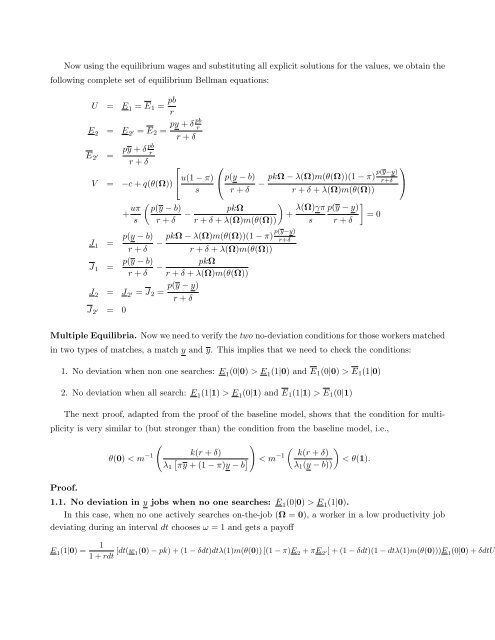Unemployment cycles
WP201526
WP201526
You also want an ePaper? Increase the reach of your titles
YUMPU automatically turns print PDFs into web optimized ePapers that Google loves.
Now using the equilibrium wages and substituting all explicit solutions for the values, we obtain the<br />
following complete set of equilibrium Bellman equations:<br />
U = E 1 = E 1 = pb<br />
r<br />
E 2 =<br />
pb<br />
py + δ<br />
r<br />
E 2 ′ = E 2 =<br />
r + δ<br />
E 2 ′ =<br />
pb<br />
py + δ<br />
r<br />
r + δ<br />
⎡ ⎛<br />
V = −c + q(θ(Ω)) ⎣<br />
u(1 − π) p(y − b)<br />
⎝<br />
s r + δ<br />
−<br />
+ uπ ( p(y − b)<br />
pkΩ<br />
−<br />
s r + δ r + δ + λ(Ω)m(θ(Ω))<br />
J 1 =<br />
p(y−y)<br />
p(y − b) pkΩ − λ(Ω)m(θ(Ω))(1 − π)<br />
r+δ<br />
−<br />
r + δ r + δ + λ(Ω)m(θ(Ω))<br />
J 1 =<br />
p(y − b)<br />
pkΩ<br />
−<br />
r + δ r + δ + λ(Ω)m(θ(Ω))<br />
J 2 =<br />
p(y − y)<br />
J 2 ′ = J 2 =<br />
r + δ<br />
J 2 ′ = 0<br />
p(y−y)<br />
pkΩ − λ(Ω)m(θ(Ω))(1 − π)<br />
r+δ<br />
r + δ + λ(Ω)m(θ(Ω))<br />
)<br />
+ λ(Ω)γπ<br />
s<br />
]<br />
p(y − y)<br />
= 0<br />
r + δ<br />
⎞<br />
⎠<br />
Multiple Equilibria. Now we need to verify the two no-deviation conditions for those workers matched<br />
in two types of matches, a match y and y. This implies that we need to check the conditions:<br />
1. No deviation when non one searches: E 1 (0|0) > E 1 (1|0) and E 1 (0|0) > E 1 (1|0)<br />
2. No deviation when all search: E 1 (1|1) > E 1 (0|1) and E 1 (1|1) > E 1 (0|1)<br />
The next proof, adapted from the proof of the baseline model, shows that the condition for multiplicity<br />
is very similar to (but stronger than) the condition from the baseline model, i.e.,<br />
Proof.<br />
(<br />
)<br />
θ(0) < m −1 k(r + δ)<br />
[ ]<br />
λ 1 πy + (1 − π)y − b<br />
( ) k(r + δ)<br />
< m −1 < θ(1).<br />
λ 1 (y − b))<br />
1.1. No deviation in y jobs when no one searches: E 1 (0|0) > E 1 (1|0).<br />
In this case, when no one actively searches on-the-job (Ω = 0), a worker in a low productivity job<br />
deviating during an interval dt chooses ω = 1 and gets a payoff<br />
E 1 (1|0) =<br />
1<br />
1 + rdt [dt(w 1(0) − pk) + (1 − δdt)dtλ(1)m(θ(0)) [(1 − π)E 2 + πE 2 ′] + (1 − δdt)(1 − dtλ(1)m(θ(0)))E 1 (0|0) + δdtU


